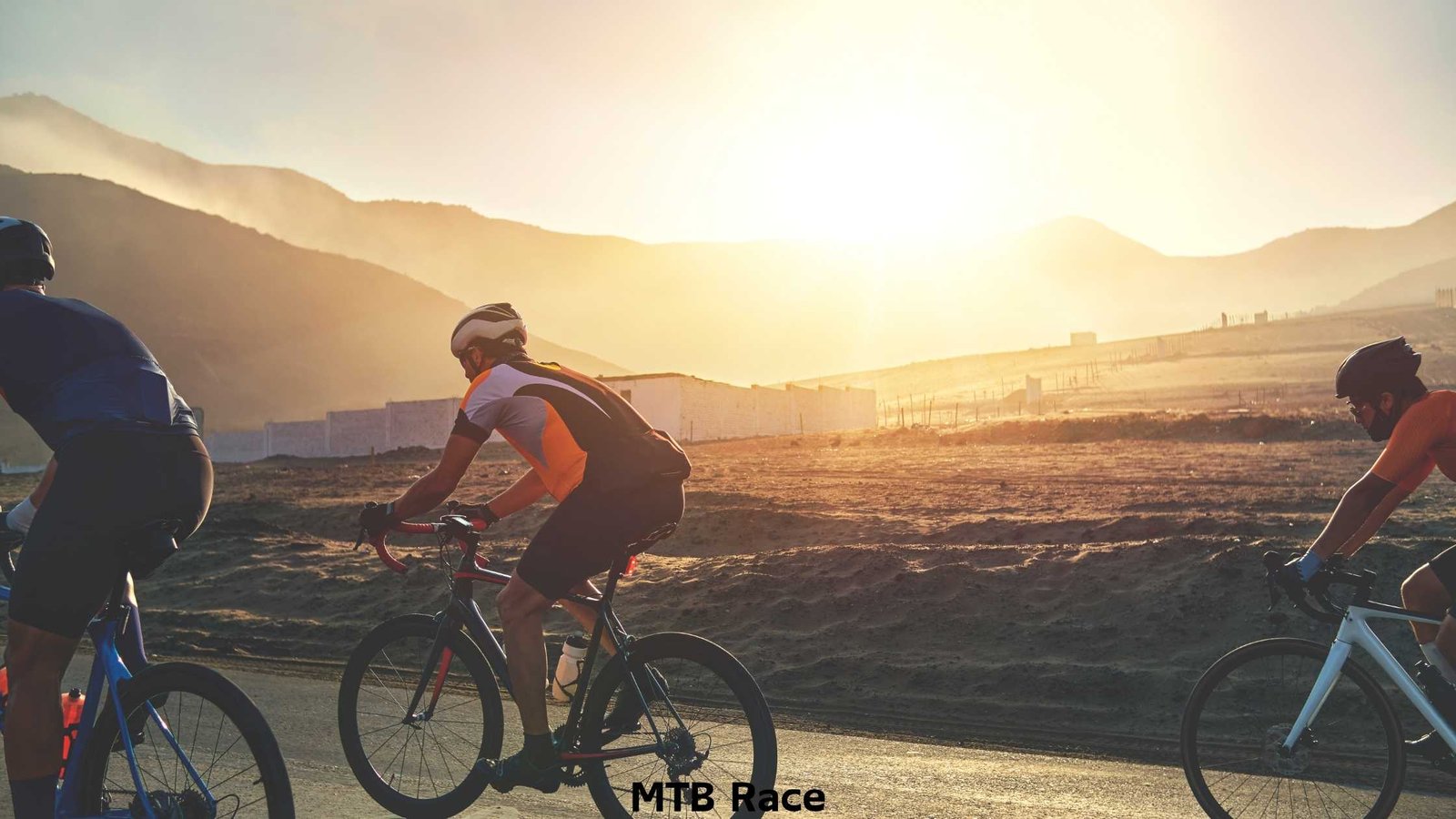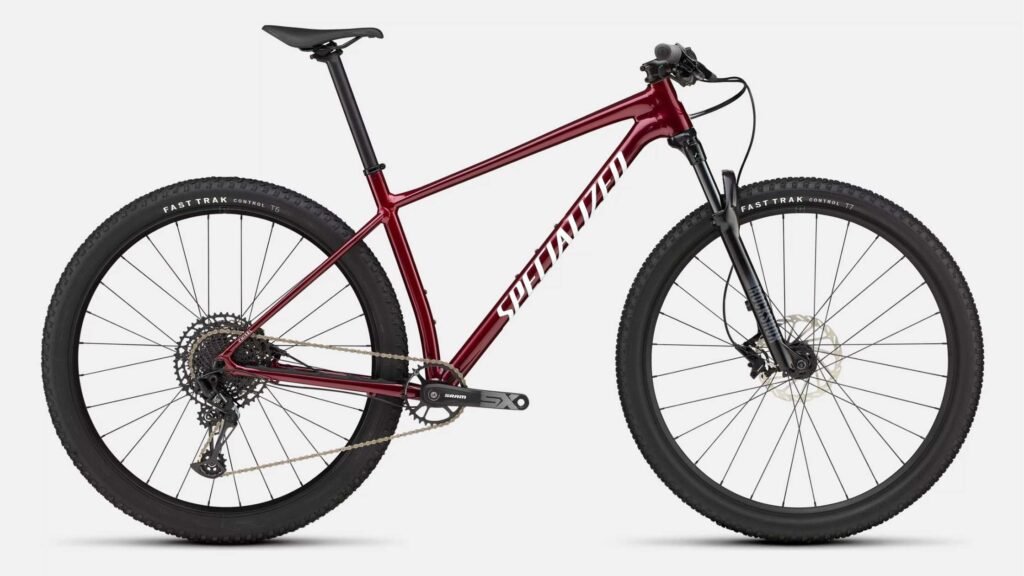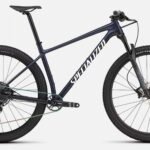Specialized Chisel vs Epic Hardtail, which is best? If you just ride for fun and often do training, then the Specialized Chisel is better as it’s cheaper, can be upgraded, easier to adapt to all trails, and has many other features.
While Epic Hardtail is for serious riders who often participate in races.
These two bikes sit right in that sweet spot where XC racing meets trail fun, and the line between them is thinner than most people think.
But the question is — which one is actually good for you?
Let’s discuss it more because what might be good for me may not be good for you.
Quick Overview — The Core Difference

Image credit: Specialized Bicycles – specialized.com
At first look, both bikes share a lot. Both are race-ready, lightweight, and made to fly uphill.
But here’s what makes them different:
| Feature | Specialized Chisel | Specialized Epic Hardtail |
| Frame Material | Premium Aluminum (D’Aluisio Smartweld) | FACT 11m Carbon Fiber |
| Weight | Around 25–26 lbs | Around 20–21 lbs |
| Geometry | Slightly more forgiving | More aggressive, racier |
| Purpose | XC + Trail crossover | Pure XC racing |
| Price Range | Lower ($2k–$3.5k) | Higher ($3.5k–$6k+) |
| Ride Feel | More compliant, versatile | Sharper, stiffer, all about speed |
The Epic Hardtail is that bike built for pure race performance — fast climbs, quick acceleration, minimal flex.
The Chisel, though, brings something else — fun and forgiveness. If you like a little comfort mixed with race DNA, that’s where Chisel stands tall.
Frame & Geometry — The Foundation of the Feel

Image credit: Specialized Bicycles – specialized.com
The Epic Hardtail’s carbon frame is insane in terms of stiffness-to-weight ratio.
It’s one of the lightest production hardtails out there, and you can instantly feel it when you stand up to sprint.
The bike responds instantly — no lag, no flex, just power straight into the rear wheel.
The Chisel, with its Smartweld aluminum, rides shockingly close to carbon. It’s the lightest alloy XC frame Specialized has ever made, and it doesn’t have that dead aluminum feeling.
The geometry is modern — longer reach, slacker head tube (68°) — which adds a ton of confidence when trails get rowdy.
Honestly, the Chisel feels like a mini Epic Hardtail that just went out for a more playful day.
It climbs like an XC bike, but the moment you point it down, it feels alive.
If you’ve read my take on Best Upgrades for Specialized Chisel, you know how much I respect that frame’s potential. With a few smart tweaks, it competes with bikes far above its price tag.
Performance in Real Trail Scenarios
Let’s put them head-to-head.
| Terrain Type | Chisel | Epic Hardtail |
| Climbing | Efficient, little flex, smooth on mixed surfaces | Lightning-fast, brutal on rough terrain |
| Descents | Feels controlled, forgiving | Razor-precise but harsh |
| Technical Trails | More forgiving geometry, better handling | Twitchier, more demanding |
| Marathon Rides | Less fatigue, better comfort | Faster but punishes your body over hours |
| Race Performance | Fast, competitive for its class | Top-tier XC race machine |
If you’re aiming to win races or want every watt to translate to forward motion — Epic Hardtail.
If you want speed + fun without the punishment — Chisel.
Components & Build Options

The Chisel often comes with SRAM NX Eagle or Shimano Deore/SLX, while the Epic Hardtail gets GX or X01, depending on trim.
But here’s the catch — drivetrain alone doesn’t tell the full story.
The Epic’s build is lighter, yes, but the Chisel gives way more upgrade flexibility. Swap the fork, go lighter on wheels, and you can drop serious weight.
If you’ve already read What Happens If You Bike Every Day for 30 Minutes, you already know — consistency matters more than the fanciest drivetrain.
The Chisel lets you grow into performance without needing to remortgage your house.
Ride Feel — Where the Difference Really Lives
Here’s the thing nobody tells you: comfort translates to speed, too.
If your bike beats you up, you’re slower at hour two than you were at minute ten.
- The Epic Hardtail is a beast on smoother, well-maintained XC tracks. You’ll fly. But hit rocky terrain or roots? You’ll start wishing for more give.
- The Chisel, on the other hand, takes that edge off. Slightly more compliance, slightly less stiffness — and that can make your overall lap time faster when trails aren’t perfect.
When you switch from Epic to Chisel, you will notice you’re 30 seconds slower in pure climb time — but 2 minutes faster on full-lap time because you will descend harder and don’t have to recover mid-ride.
Weight & Efficiency — Not Just Numbers
The Epic Hardtail wins the weight game. PERIOD.
That FACT 11m carbon frame is ridiculously light. But here’s where riders get trapped — weight is just one metric.
If you’re running a Chisel and you throw on a set of lightweight wheels, a carbon bar, and an upgraded fork, you can drop the gap considerably.
I’ve written before how smaller upgrades can transform your riding efficiency — check out 9 Effective Ways to Build Stamina for Longer Mountain Bike Rides.
You’ll be shocked at how much fitness and setup balance can overcome 1–2 lbs of frame weight.
Race Use vs Daily Riding

Let’s be blunt — Epic Hardtail isn’t built for chill days.
It wants to go hard, all the time.
If you’re training seriously, racing often, or just addicted to KOMs — that bike feels like a weapon.
Every climb feels like it’s pulling you up, not the other way around.
But if you ride trails for fun, train on weekdays, maybe race a couple of events a year, the Chisel gives way more balance.
You can bomb descents, hit jumps, or take long fitness rides without needing chiropractor appointments.
Handling & Geometry Breakdown
Let’s talk a bit technical — because geometry tells the truth about how a bike behaves.
- Epic Hardtail: 68.5° head tube angle, shorter reach, lower stack. This geometry screams race-first.
- Chisel: 68° head tube, slightly longer reach, taller front. This setup brings stability.
If you’re newer to XC or coming from trail bikes, you’ll immediately feel more confident on the Chisel.
The Epic demands precision — it’s sharp but punishes mistakes.
So, unless you’re all-in on racing, the Chisel gives you more “fun room.”
Upgrade Potential
The Chisel wins here easily. It’s a tinker-friendly frame.
You can lighten it up, upgrade components gradually, and it just keeps scaling with you.
The Epic Hardtail, on the other hand, is already near the ceiling. It’s built to race — minimal room for upgrade satisfaction because it’s already maxed out.
If you’re thinking of investing long-term and upgrading as you grow, read Starting Mountain Bike at 40 — 10 Tips to Follow. That mindset applies perfectly to the Chisel — progress step by step.
Pro Tip: Chisel + carbon wheelset + dropper post + 100mm SID fork = near-Epic performance, but more forgiving.
Who Should Choose Which?
Here’s the real talk breakdown:
Choose the Specialized Epic Hardtail if:
- You race XC seriously or plan to.
- You want the absolute lightest setup.
- You ride smooth, fast trails.
- You’re okay with stiffness over comfort.
Choose the Specialized Chisel if:
- You ride both trail and XC.
- You care about value and upgrade flexibility.
- You ride technical or mixed terrain.
- You prefer comfort that doesn’t kill speed.
Real Ownership Experience
After trying on both, here’s what stands out:
- The Epic Hardtail feels like a laser — incredible precision, but it’s intense.
- The Chisel feels more like a knife that can still carve, but doesn’t cut you if you slip.
Maintenance-wise, the Chisel’s aluminum frame is worry-free. No carbon anxiety, no hairline crack paranoia. Just ride, clean, repeat.
And that’s why many riders, even experienced ones, end up keeping their Chisel longer. It’s simply more livable.
The Verdict (Before We Wrap It Up)
If we’re being honest, 90% of riders who think they “need” an Epic Hardtail actually fit better on a Chisel.
It’s faster than it looks, cheaper to run, and more versatile to live with.
The Epic Hardtail is unbeatable for serious XC racers — but for most people, the Chisel gives 90% of the speed with 30% more fun.
Conclusion — Chisel or Epic Hardtail?
At the end of the day, both bikes are absolute machines, but made for different riders. The Epic Hardtail is that no-nonsense race rocket — built for people chasing podiums, counting grams, and shaving seconds.
So, if your main thrill comes from power transfer, efficiency, and climbing PRs, that’s your bike.
But if you want something that keeps you smiling on every ride — from XC loops to light trail days — the Specialized Chisel just hits better.
It’s more forgiving, more playful, and more affordable to maintain.
You can ride it every day, push it hard on weekends, and it never feels like “too much bike.”
I’ve said this before — the Chisel is the one bike that makes you want to ride more. It’s got that balance between speed, fun, and practicality.
If you’re not racing full-time, you’ll probably be happier and faster longer on the Chisel.
FAQs — Specialized Chisel vs Epic Hardtail
Here are some important questions and their answers.
Which bike climbs better — Chisel or Epic Hardtail?
The Epic Hardtail is better to climb on smooth terrain because of its lighter carbon frame and stiffer rear triangle.
But on technical climbs, the Chisel’s geometry and compliance actually make it easier to stay seated and maintain traction.
It’s not always about raw speed — it’s about control.
Can you race competitively on the Chisel?
Absolutely. The Chisel has proven itself in countless amateur XC races.
Throw in a carbon wheelset and lightweight fork, and it’ll hold its own against full-carbon setups.
Unless you’re going pro or racing elite-level events, you won’t “need” more than the Chisel.
Is the Epic Hardtail worth the extra cost?
If your focus is racing-only, yes — it’s purpose-built, super light, and really fast.
But for most riders, the extra cost doesn’t translate into a better overall experience. The Chisel gives 90% of the performance for roughly 60% of the cost.
Which bike is better for rougher trails or longer rides?
The Chisel wins here, easily. The frame has more give, geometry feels more stable, and you’ll finish rides fresher.
For long XC-marathon type days, it’s the smarter choice unless you love punishing yourself.
Can the Chisel be upgraded to match the Epic Hardtail’s performance?
Yes, and that’s the best part. With upgrades like a SID or Fox 32 fork, carbon wheels, and a 1×12 GX drivetrain, your Chisel can hit the same weight range as lower-tier Epic builds.
Check my article on 9 Effective Ways to Build Stamina for Longer Mountain Bike Rides — because pairing upgrades with better endurance will take your Chisel even further.

Ali is the founder of Mountain Bike Insider and an passionate rider with years of hands-on experience in mountain biking. From testing gear to exploring trails, Ali writes based on real riding knowledge to help others make smart, safe, and enjoyable biking choices. Every guide is built on research, personal use, and a passion for the sport.







